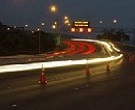A selection of questions posted by students. Answers were provided by Smart Motorway experts and by Shelley the LEARNZ Field Trip Teacher.
- How do you make roads and what materials do you use and how do you make the materials and how do you keep the roads balanced so it wont collapse and also how do you know they are safe to cross on?
It depends on where the road is but most roads are constructed in a similar way. Different materials and thickness of seal will be used to suit the area where the road is being built. The smart motorway will have a special type of seal that is safer when wet, will last longer and be quieter to drive on. Like all construction there are strict rules about how strong the road has to be - it will be tested to make sure it meets these standards. Reinforced concrete (concrete with steel in it) is used for bridges and retaining walls and the ground is compacted so that it will not move or slump. You can watch this video from the Waterview Connection field trip to find out more about how roads are sealed. - Why are smart motorways considered safer for motorists and has this been the case overseas? - Harriet
Used in UK and Australia - evidence is fewer accidents becuase of reduced congestion. Less braking and accelerating, less lane changing. Also incidents are automatically detected so safety plans can be started up. - How does the automatic adjustment to the speed limit ease congestion, and how often would the speed limit change? - Connor
The computer checks the detectors every five minutes and can change the speed limit if need be. NZ system has a computer model to try and predict what should be done. - Are lanes manipulated to give emergency services ease of travel through dense traffic? - Harry
Yes. Dedicated on-ramp at Ngauranga Gorge. Controllers at TOC can see the emergency services from their cameras and can change the signs to alert drivers to change lanes and slow down to let emergency services through. - How reliant is the smart motorway on the WTOC operators and how would this system work in the case of a community emergency such as an earthquake? - Casey
At TOC the operators are trained to monitor traffic and intervene in emergencies. Listen audioconference 1 for what happens in a power outage. - Are the message board messages manually typed in or is there a variety of automated messages?
Yes, they are a very important feature. Messages are both automated and manually entered. - How do the 'loops' function as detection equipment and what is their purpose? - Rhys
They are loops of wire cut into the road surface that are linked to the computer. They detect a vehicle going over, the same way as loops in the road beside traffic lights work to trigger a change in the lights. Loops on the smart motorway will detect the number of cars and therefore the amount of traffic to help calculate the best speed for cars to travel at. - How will you educate drivers about the importance of minimal lane changes and other smart motorway behaviours? - Charlotte
Campaign on billborads, radio, YouTube videos. Messages will be getting in lane early and not changing and following the speed limits. - What happens to the money from the speed cameras on the motorway? - Aubrey
It doesn't go to NZTA or the Police. It goes into the Government's consolidated fund to spread over all services like health and education. The smart motorway's prime purpose is not to catch speeders but improve the flow of traffic. - Can you please explain how the 'Vissim' model is designed and how it functions in replicating driver behaviours? - Lucinda
Made in Germany in 1992 - translates as Traffic in Cities simulation. Can programme all road users with physical and psychological factors and will show where traffic queues are so strategies can be tested on the model to reduce the queues. - Is Wellington first in New Zealand with this technology and is this technology being considered for all new motorways in New Zealand by the NZTA? - Lauren
This one in Wellington is NZ's first. The prediction system is a world first and is being considered for other places in NZ. Have to choose most appropriate road eg one which is tricky to widen because of rivers, sea, hills, railway lines, big buildings etc. - When will this smart motorway be open?
The last big job to do is laying the road surface which is called EMOGPA this is a smart new epoxy product which improves the journey for road users and lasts much longer than other surfaces. It reduces road noise and water spray, and is expected to last up to 30 years – that’s four to five times longer than standard products. The expected opening is the middle of May 2016. - Has anything come up during this process that you would change or add to when you build another smart motorway?
Biggest learning is around the software developed. The next project will be able to use the software developed for this project. - How many of the flashing signs are there going to be in the smart motorway network?
Fifteen ganties each has a sign over each lane (4 lanes) on each side ie 15 x 8!




